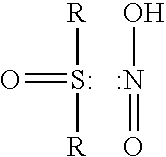Method for removing acidic gases from waste gas
a technology of waste gas and acidic gases, applied in the direction of alkali metal sulfides/polysulfides, separation processes, sulfur compounds, etc., can solve the problems of smog and human discomfort and disability, the problem of no/sub>x is even more difficult to overcome, and the process is not suitable for the removal of nitrogen oxides
- Summary
- Abstract
- Description
- Claims
- Application Information
AI Technical Summary
Benefits of technology
Problems solved by technology
Method used
Image
Examples
example 1
[0061]A glass column of 400 mm height and 30 mm diameter was heated by an outer electric heater to 80° C. The glass column was filled with glass rings of 4 mm height and 4 mm diameter and with 100 g emulsion of water in diesel derived sulfoxides comprising of 30 g water in 70 g sulfoxides. A stream of air containing 1.9% (mass percent) NO2 was bubbled continuously through the bottom of the column at a rate of 0.29 l / min for 42 hours continuously. About 75-90% of NO2 was consumed.
[0062]After 42 hours, the liquid in the column was collected and separated into two phases. The concentration of nitric acid in the aqueous phase was 20.3 wt. %.
[0063]The amount of nitrous and nitric acid in the sulfoxide phase was determined by potentiometric titration in non-water medium and was found to be 21% of the total acid. In order to destroy the nitrous acid—sulfoxide complex, water were added to the organic phase and oxygen was bubbled into the liquid in order to oxidize all nitrous acid molecules...
example 2
[0066]SO2 absorption was conducted under the same conditions as in Experiment 1. SO2 concentration in the input gas was 2000 ppm. The process was carried out for 42 hours during which more than 90% of SO2 were absorbed without observing loss of absorption capability. The aqueous phase obtained at the end of the process contained only sulfuric acid. No sulfite ions (SO3) were detected.
example 3
[0067]NO2 and SO2 absorbtion was conducted simultaneously with the same reactor and emulsion composition as in Example 1 but at temperature of 20-25° C.
[0068]The concentration of NO2 was 1000 ppm and that of SO2 800 ppm.
[0069]The process was carried out the for 8 hours continuously and during this time no reduction in the absorption capability of the scrubbing agent was observed. The average concentrations of NO2 and SO2 at the output were less <10 ppm and <2 ppm respectively.
[0070]The aqueous phase obtained after collecting and separating the emulsion contained a mixture of nitric and sulfuric acids.
PUM
| Property | Measurement | Unit |
|---|---|---|
| Fraction | aaaaa | aaaaa |
| Weight ratio | aaaaa | aaaaa |
| Acidity | aaaaa | aaaaa |
Abstract
Description
Claims
Application Information
 Login to View More
Login to View More - R&D
- Intellectual Property
- Life Sciences
- Materials
- Tech Scout
- Unparalleled Data Quality
- Higher Quality Content
- 60% Fewer Hallucinations
Browse by: Latest US Patents, China's latest patents, Technical Efficacy Thesaurus, Application Domain, Technology Topic, Popular Technical Reports.
© 2025 PatSnap. All rights reserved.Legal|Privacy policy|Modern Slavery Act Transparency Statement|Sitemap|About US| Contact US: help@patsnap.com



